"It is one of the occupations to dry plants & papers,
& we spare our room carpet by keeping it covered with papers!"
Jane Gray's diary, 21 March 1885
In 1885 Asa Gray (1810-1888), his wife Jane Loring Gray (1821-1909), and William Gilson Farlow (1844-1919) took a four-month collecting trip that began in Alabama and ended in California. It was the Grays' penultimate trip-Asa was 75 and this was to be the last true collecting trip of his life. The couples' final sojourn, to Europe in the fall of 1887, was "a holiday of art galleries and cathedrals from Vienna to Normandy". [Hunter Dupree, Asa Gray, pg 411]
Asa Gray showed his interest in botanizing in Mexico from an early age. In 1832 he wrote to his mentor and colleague, John Torrey (1796-1873), that he was looking for a position and that he wished to collect in Mexico. "I have for some time been inclined to prefer Mexico, both on account of the salubrity of its climate and of its botanical and mineralogical riches, which so far as I know have never been thoroughly explored." [Asa Gray to John Torrey, 6 April 1832 Letters, I, pg. 36, Library of the Gray Herbarium] It would be another 53 years before this trip would occur, but by then he would travel with W.G. Farlow, a botanist whom he had mentored.
It is unclear if any event precipitated this trip. Gray wrote to Joseph Dalton Hooker (1817-1911) in January of 1885 that they were thinking of "getting off for the later part of winter" and that, although they had no definite plans, were leaning toward visiting Arizona and California. Certainly many West Coast botanists were encouraging the Grays to visit them. William Scrugham Lyon (1852-1916), the author of Gardening in California, wrote to Jane in 1884 that the winter weather in California would be beneficial to Asa's health. He wrote "...wishing I were his medical advisor and I would promptly insist on California climate ad lib." [W.S. Lyon to Jane Loring Gray, 18 April 1884, Archives of the Gray Herbarium]
Farlow was also encouraged to come West by many of his contemporaries and the trip was quickly planned. On Tuesday, February 3, 1885, the Grays left Cambridge for the first stop on their journey, St. Louis, Missouri.
"We left home February 3, in bitter cold, for St. Louis, where I had an interview with old Shaw, and heard him read his rearranged will, which is satisfactory, as it will allow his trustees, and the corporation of Washington University there to turn his bequests to good account for botany; will be an endowment quite large enough for the purpose. Thence, rail-two nights, and a day-to Mobile, where it was warm and springlike, but no flowers out, barring an early violet." [Asa Gray to J.D. Hooker, 22 Feb 1885, Letters, II, pg. 761, Library of the Gray Herbarium ]
According to Jane's diary this first leg of the journey was not without incident. The snow detained them in Detroit and they missed their first connection. The weather in St. Louis was poor and both the Gray's were not feeling well. St. Louis was not impressive, as Jane writes, "the mud! like Washington in war time, & the smoke, & so dirty!" [Jane Gray's journal sending from 8 February 1885]. On Friday, February 6th, they were back on the train headed for Alabama. The train was very crowded with passengers heading to the World's Fair in New Orleans (also known as the World's Industrial and Cotton Centennial Exposition). The Grays reached Alabama on February 8th expecting to meet Farlow the next day. Unfortunately, Farlow experienced many of the same problems and missed his connecting train because of bad weather. He sent a telegram to the Grays to let them know that he was delayed a full half day or more. Asa was on edge because their next stop was New Orleans and all his requests for hotel rooms were met with replies of "impossible!" with the Exposition in town. [Jane Gray's journal sending* from 14 February 1885, Archives of the Gray Herbarium]. He decided to take an earlier train to secure lodgings and left Jane to Farlow so they could proceed to New Orleans together.
The next morning Jane was sick with a cold, but headed to the telegraph office only to discover that there was no word from Farlow. She left a note for him with the clerk, explaining the situation and asking him to meet her at the hotel. Mrs. Gray returned to the hotel where she packed and rested prior to checking out at 4:00 p.m., but still with no word from Farlow.
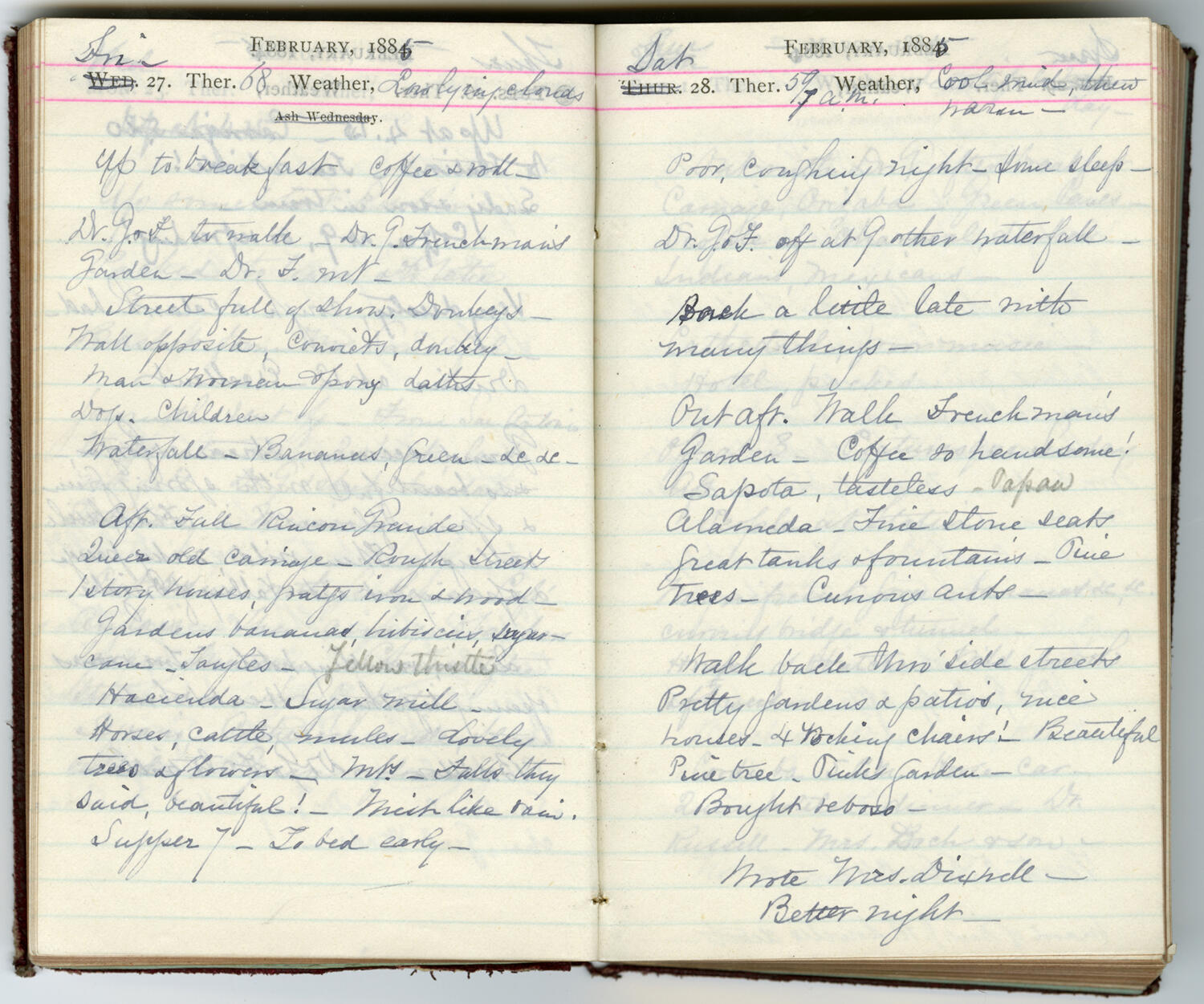
Jane returned to the telegraph office where she found a telegram waiting from Asa. He sent the good news that he found a hotel and would wait for them at the train station. Alas, there was still no word from Farlow so Jane asked the clerk to hold a card for him that gave the name of the New Orleans hotel. Then she "...went to the coming train, it came in two sections, I looked thro' the passengers getting out on the first, & in the Battle House omnibus, no Dr. F. The Woodbridges [a couple she met at the hotel] were getting into an empty car, so I thought it best to join them rather than go alone-If I had only waited for the second section in which Dr. F. was!-and that clerk gave him my note & never the card, & he did not know how to find us!" [Jane's journal sending from 14 February 1885] It took another two days for the party to be reunited. Farlow was in Mobile with no idea where the Gray’s were and Gray in New Orleans "bothered and worried" but not able to reach Farlow. Finally Farlow took a train to New Orleans and contacted their mutual botanist friend, John Gill Lemmon (1832-1908), to explain that he was staying at the Hotel Royale and he was ill and going to head home. He wondered if Lemmon be kind enough to tell him where Grays were? Lemmon sent word to Gray and, as Jane writes in her diary, Asa rushed out to meet him. "It seemed despairing on both sides of finding each other-But after that was a happy ending & I think now we shall be shy of separation." [Jane Gray's journal sending from 14 February 1885, Archives of the Gray Herbarium].
Dr. Farlow had a surprise when he finally reunited with the Grays: He was given free passes for the Mexican Central Railroad from El Paso, Texas, to Mexico City and back to El Paso, the junction with the road to California. They only had to pay for their berths and seats in the Pullman car and Gray, "could not resist the temptation." [Asa Gray to Richard Church, 30 March 1885, Archives of the Gray Herbarium]
During the three months of the trip the Grays and Farlow rode many trains. The party traveled on both the Atlantic and Pacific Railroad and the Mexican Central Railroad, which were both newer lines. In fact, the Mexican Central Railroad had been running for less than a year, which might be why they were offered free passes.
Train travel during the 1800s was very different than it is today. Passengers could pay for different levels of service and were assigned to specific corresponding cars. The third class, or cheapest fares, allowed a passenger access to an open car with a hard wooden seat. There was no dining facility so travelers packed their own food and the men and women shared a single washroom. Second class travelers enjoyed an enclosed car with padded seats and separate "facilities." They could also choose to bring their own food or dine in buffet car. First class passengers luxuriated in an enclosed car with leather upholstered seats and a first class dining car and a buffet car. The washrooms were segregated and located a different ends of the car to ensure privacy. Some early first class cars had wooden bunks, but it was not until the introduction of the Pullman Sleeping car in the late 1850's that long distance train travel became comfortable for those who could afford to pay.
The Pullman cars had padded velvet seats that unfolded into plush beds. Other styles pulled down from the ceiling and had privacy curtains. The cars were often made from fine woods like mahogany, black walnut, or oak, and had etched glass doors, and beautiful chandeliers to light the space. The men had a salon equipped with a wash room and lavatory with hot running water while the ladies enjoyed similar luxuries and a dressing room at the opposite end of the car.
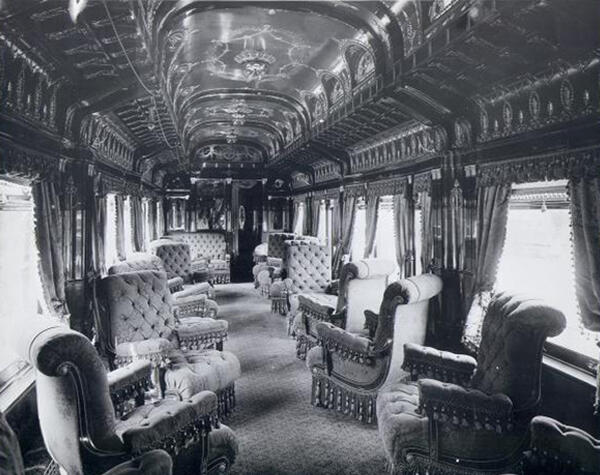
By the early 1880s when the Grays and Farlow were on their West Coast adventure, Pullman cars were on nearly two-thirds of the nation's tracks. According to Jane's diary and journal sendings the majority of their travel was spent in these Pullman cars. After they left Mississippi for San Antonio, on the way to Mexico, they had to change to a Silver Palace Sleeper and it was not the same. She wrote "Silver Palace don't believe in Lady's room or brushing teeth!" [Jane Gray diary, 14 February 1885, Archives of the Gray Herbarium]
Gray's health continued to deteriorate. When they arrived in San Antonio he took to his bed while Farlow and Jane strolled about town. On February 17th he was well enough for them to continue their journey. As their train traveled along the Rio Grande toward Mexico, Jane wrote:
"The old army road lay along our track a good deal of the day, the same Ch. Wright so many years ago accomplished the laying out ...The men seem to wear nothing but a loose jacket or shirt & pantaloons of white cotton, though when very hard at work they will have a leather apron before & behind, like split up trousers - And their feet have on sandals, held by innumerable leather thongs...As for the men's hats! Immense things of felt or straw, tall crowns, wide brims - Felt generally light, & many have a deep scalloped black band, or various cords & silver ornaments & binding- The straw have often a pattern of silver worked on the crown and again on the brim - The variety is immense...We were startled in the night by a crash, & found a stone had been thrown through one of the windows, it made such a round hole through the double windows it seemed like a shot - Fortunately no one was in that section - We woke to Yuccas as big as trees - Big trunks some 8 or 10 ft high, branching off & looking like rather abortive attempts at trees. " [Jane Gray's journal sending undated, Archives of the Gray Herbarium].
The party reached Mexico City at 9:00 a.m. on Saturday, February 21, 1885. Both Asa and Jane were very sick, their colds had gotten much worse and the altitude was making it even more difficult to breathe.
"We are comfortably placed in the Hotel Iturbide. Farlow and I have looked about somewhat, though I am still suffering from catarrh and cough; Mrs. Gray laid up with hers. This afternoon an[sic] Mexican gentleman to whom we took letters called and drove Farlow and me out to Chapultepec, whence a most magnificent view of the whole Valley of Mexico and the surrounding mountains, including Popocatapetl and its more broadly snowy companion, -with its more difficult name, meaning White Lady, -at this season always with cloudless tops. The cypress of Chapultepec are glorious trees, plenty of them, full of character, and of a sort which should help to distinguish the Mexican species from the North American. I wish you could see them. And such old trees of Schinus molle, the handsomest of trees either old or young, the old trunks wonderfully bossed. Is it a native of Mexico? I thought only of Chili? But it is well at home here. Such yucca trees as we have seen on the way here, with trunks at base two or three feet in diameter, weirdly branched, looking like doum palms. Opuntias of two or three arborescent species, some huge, and other cacti not a few." [Asa Gray to J.D. Hooker, 22 Feb 1885, Letters, II, pg. 761, Library of the Gray Herbarium ]
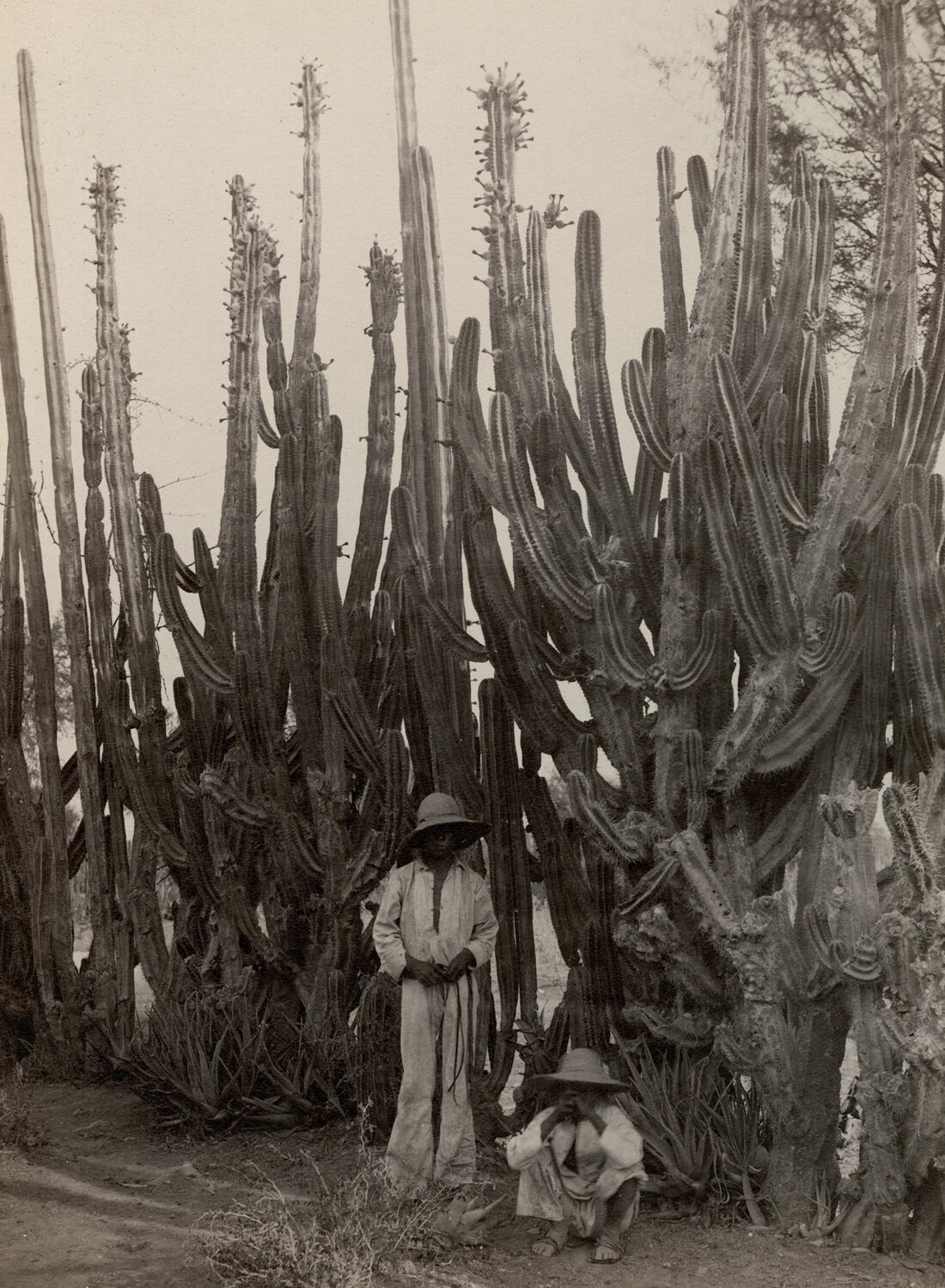
The Grays' colds did not improve and a physician was called in. He prescribed some medication but also told them that the best thing they could do would be to leave Mexico City for Orizaba. As Asa wrote, "Farlow and I have been mousing about the city of Mexico, I coughing most of the time, in a clear, dry air and nearly cloudless sky, weather which should be most delightful, but somehow it is bad for the throat (for the natives as well as for us), and the rarefied air puts one out of breath at a little exertion." [Asa Gray to J.D. Hooker, 27 Feb 1885, Letters, II, pg. 763, Library of the Gray Herbarium]
Because of their difficulty breathing (the altitude was about 8000 feet), the party took the doctor's advice and traveled down to Orizaba, approximately 4000 feet lower. The hotel they found was a bit strange. "It was a queer, rambling house, rooms opening any where, no galleries or passages except from the entrance stairs, & all above the ground floor-We had to take a room inside Dr. Farlow's, but large and comfortable tho!" [Jane Gray's journal sending, 26 February 1885, Archives of the Gray Herbarium]
They thoroughly enjoyed Orizaba. The climate was much better for their breathing and the local food was much to their liking. Jane wrote that the oranges were plentiful and among the best she had ever eaten. Gray was even more impressed and, in a letter to Richard Church, reported that all the fruit there was the best that he had ever tasted. [Asa Gray to Richard Church, 30 March 1885, Archives of the Gray Herbarium] The collecting was plentiful and the vegetation beautiful as well. "I saw real papaya trees which look like great Euphorbias 20 or 30 ft high, & big rough eggplants growing below the tufts of leaves on top-He gave us a black sapote [Diospyros digyna called Chocolate Pudding Fruit or Black Persimmon] which I tho't very tasteless-And as Dr. F. said, "why would anyone grow zinnias & larkspur & such things when such lovely things were to be found on all sides?" [Jane Gray's journal sending, 28 February 1885, Archives of the Gray Herbarium]

After three and a half days in Orizaba the party made a further descent of 2000 ft by a "wonderful piece of railway" to Cordoba. The accommodations were very primitive; especially for Farlow "he had nothing but the door for air or flight & was next to the stables!" [Jane Gray's diary, 1 March 1885, Archives of the Gray Herbarium]. The men went out botanizing but, while searching the river bank, they accidentally stumbled across a hornet nest. While trying to rush away from the stinging insects, Gray's spectacles dropped into the water and, while Farlow fished them out, they were both badly stung. Jane was forced to stay in the hotel because there were no carriages available to let in Cordoba. But her time was not without adventure. "As I sat writing in our room I heard steps in the courtyard, & peeping thru' our upper door, I saw 4 men bringing a stretcher & 2 soldiers accompanying-They went to the room opposite ours, across the court, lifted it in, & I saw them take something apparently from the bed, lay it down on the stretcher, adjust the pointed cover, then they carefully lifted it out & over the railing, the 4 men took each an area, the soldiers accompanied, & marched off-Was it not mysterious? An hour or two after the man came & cleaned out the room-But no one from the hotel seemed about at the time." [Jane Gray’s journal sending, 2 March 1885, Archives of the Gray Herbarium]
Their time in Cordoba was not all bad. "Mrs. Dock & her son returned about 2pm from a walk with Dr Russell, & brought Dr. G. such an Aristolochia blossom, half a foot in diameter certainly & a foot long! How beautiful the velvety inside was! Dr. G. tried to preserve it, but had to give it up. -It spoiled everything..." [Jane Gray’s journal sending, 2 March 1885, Archives of the Gray Herbarium] [According to Favio González at the Colombian National Herbarium, this was probably a flower of Aristolochia grandiflora.]
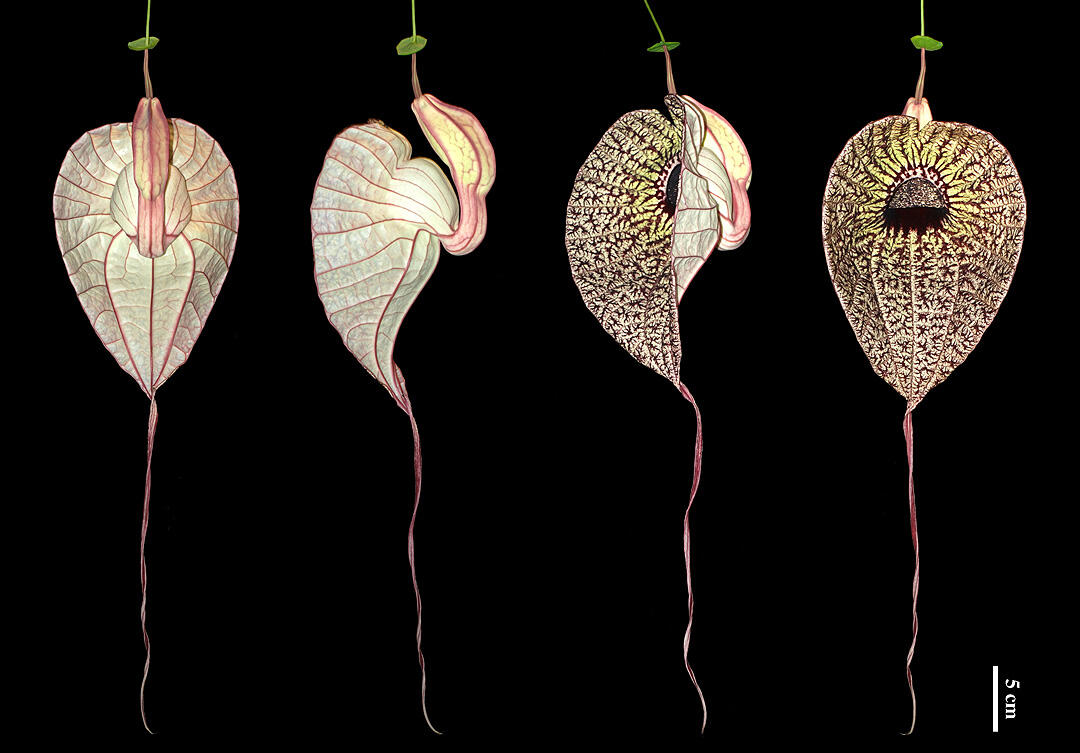
After two days, the party headed back up to Mexico City. They stayed in Mexico City a couple of nights and, on the morning of March 5th, left Mexico on a train headed to El Paso, Texas. The train ride back into the states was picturesque but very crowded. While heading into Mexico they were the only passengers going all the way from Texas to Mexico City; going the other way the train was packed. Every section was full and for every person that got off, another was waiting to fill his or her place.
The party reached Santa Monica, California on March 15th. It was quite lovely there but Jane was beginning to miss Cambridge. "It certainly is very charming & fascinating to see things growing so beautifully out of doors, roses & geraniums & calla lilies & heliotrope & begonias & passion flowers that are green house plants with us, but I do not think Los Angeles very attractive. It is a large burg town, with rows of showy stores & there are many pleasant private houses-But it looks new, and one misses anything like an old tree-Eucalyptus, pepper trees, & the occasional sycamore are the general shade trees..." [Jane Gray’s journal sending, 15 March 1885, Archives of the Gray Herbarium] They stayed in Santa Monica for two days and then split up. Farlow took the quicker method, a boat to san Diego, and the Grays continued on by train because Jane was not comfortable sailing. Unfortunately, the train was crowded, with many screaming babies, and Asa had begun to feel poorly again. They arrived in San Diego the afternoon of March 18th, and by this time Gray was miserable and had to spend the first few days mostly in their room, resting. His breathing was very labored and he was often feverish. While Jane worried about him she was also a little amused to see that the newspaper The San Diego Union included a large notice, heralding their arrival but indicating that while Farlow was out collecting Gray was in poor health and "will devote the time entirely to recuperating his somewhat enfeebled health". [San Diego Union, 20 March 1885, Archives of the Gray Herbarium]
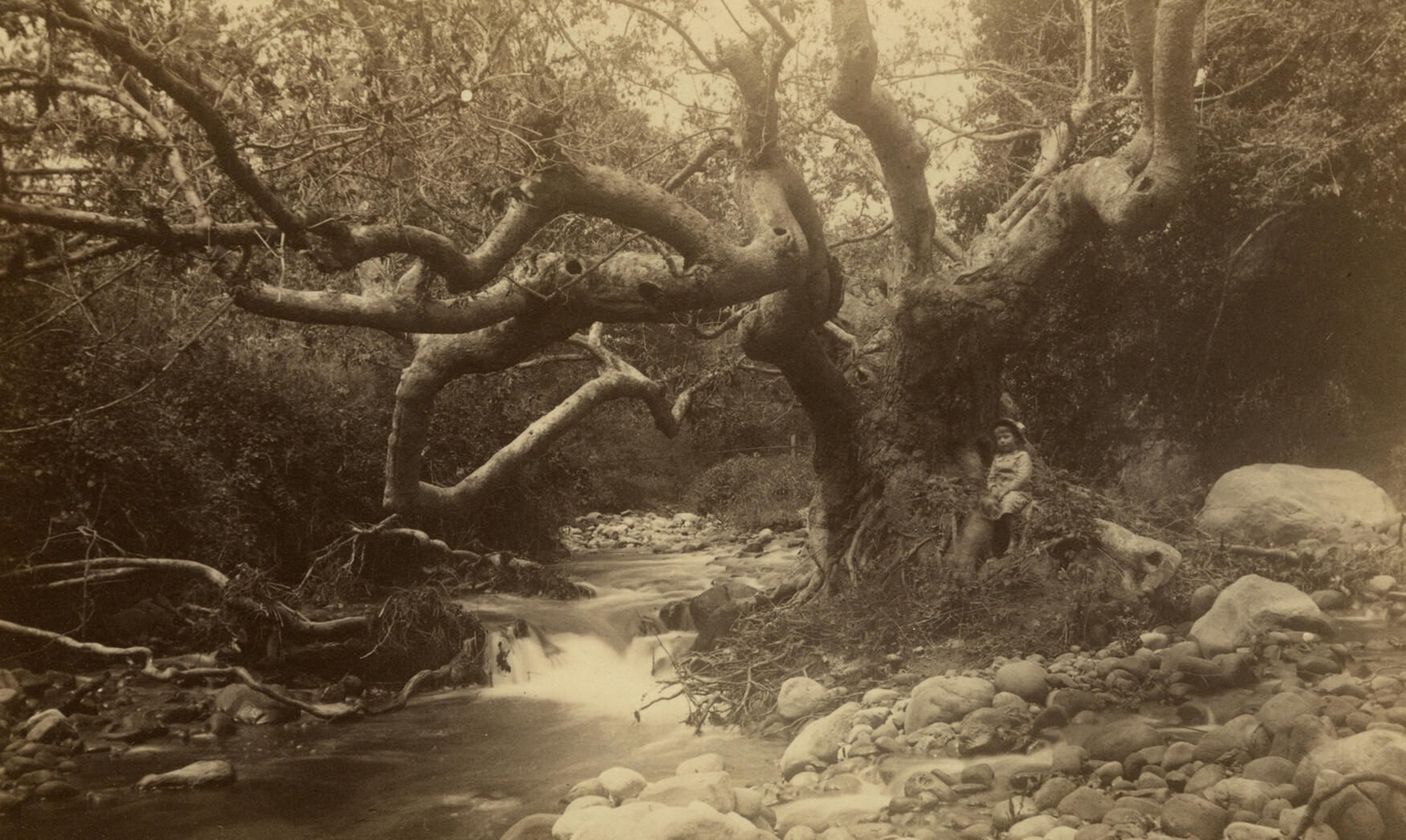
While Gray rested Farlow went out collecting. It was a chilly and windy day and he returned to the hotel with a sick headache. Saturday, March 21st was spent indoors, recuperating and receiving visitors. Jane tried in vain to keep Asa resting but he could not stop talking about botany with Farlow and other local botanists Charles Russell Orcutt (1864-1929) and Daniel Cleveland, who were working with them on area plants and hurt his throat.
The party left San Bernadino on March 26th and arrived in Santa Barbara on Sunday March 29th to some unexpected fanfare. The Mayor of Santa Barbara, George W. Coffin, was awaiting their arrival and took them by carriage to their hotel. "Then we were usher [sic] to our rooms, which adjoined each other, pleasant, good sized rooms, the beds in adjoining rooms like alcoves, and found there bowers of flowers! There were ten bunches of the most lovely roses & other flowers, & a large bouquet of wild flowers-The richest of Bougainvillea, cape bulbs, etc-On my bureau in one glass were 14 buds of the most exquisite & enormous Marechal Niel [a type of tea noisette rose] & a long wreath of Banksia roses-You may be sure it was quite enchanting! And was it not kind?" [Jane Gray's journal sending, 29 March 1885, Archives of the Gray Herbarium] Gray later told Hooker that "Mrs. Gray was fairly taken off her feet." [Asa Gray to J.D. Hooker, 1 May 1885, Letters, II, pg. 767, Library of the Gray Herbarium ]
Soon after their arrival Gray and Farlow were invited to a meeting of the Natural History Society and Farlow was asked to address the membership. He gave a very well received talk on the fungus diseases of plants. Santa Barbara was very pleasing to all of them; the weather was warm but not hot, the scenery was beautiful, there were many friends to visit with, and many plants to collect. Gray described it as "the most delicious part of California". [Asa Gray to Richard Church, 30 March 1885, Archives of the Gray Herbarium]
Farlow was able to reconnect with an old correspondent, Sarah B. Cooper, who was interested in ferns and algae. During the next few days he spent quite a large amount of time collecting with Mr. & Mrs. Cooper as well as with Henry C. Ford. The Gray's went along one day as well. "When the road & valley became too rough, we left the wagon and walked on-The rocks each side rise some 100 feet or more-Dr. Gray was finding plants & flowers, Dr. Farlow lichens & fungi-He found in the garden on the hollyhocks a fungus which has been a great pest in Europe, but never know [sic] before in the United States, and he found some on a mallow in the canyon." [Jane Gray’s journal sending, 29 March 1885, Archives of the Gray Herbarium]
The Grays and Farlow took a break from collecting to attend the Santa Barbara Flower Show on both April seventh and eighth. Gray had been asked to give an address and was feeling good enough so, on Wednesday afternoon, he spoke on Nature and Art and the wonders of California. On the tenth they traveled to Santa Paula and then on the twelfth to San Francisco, their penultimate stop in California. The day after they arrived they slept in a little and as they had their late breakfast, "We had a little earth-quake at Newhall (?), that Dr. Farlow might complete his California experiences! I wondered what they were doing down stairs to shake the wall so, & as it came again thought 'an earthquake!' And as I looked up met Dr. F's cry 'an earthquake!' Dr. Gray was more in the middle of the room & reading did not notice it-It was quite severe in some places." [Jane Gray’s journal sending, 13 April 1885, Archives of the Gray Herbarium]
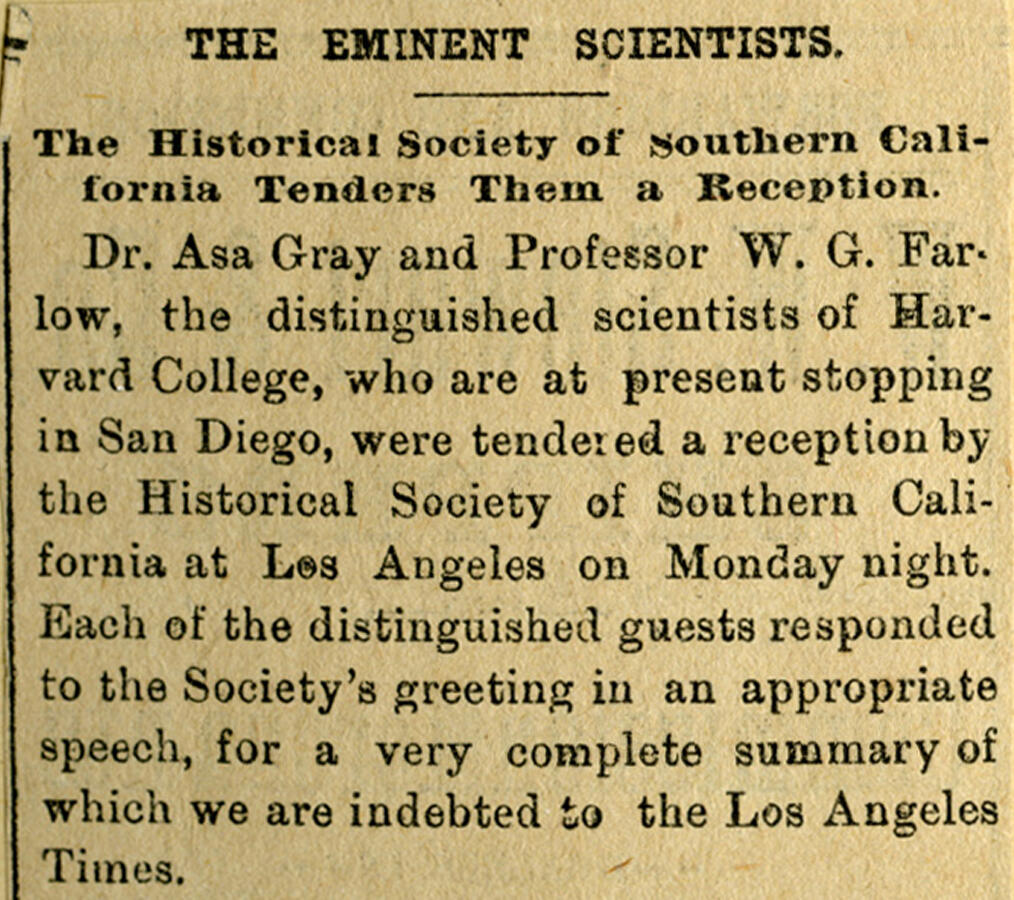
That evening classmates of Farlow, Dr. Brigham & Mr. Taylor, invited them to stay for the Thursday Evening dinner of the Harvard Club. Jane really enjoyed San Francisco. She writes, "The street cars in San F. are quite wonderful, many of them, all up the steep hills, & very steep they are, like climbing a house roof, going by underground cable, so you seem to move by magic. A closed car, & open car in front like an Irish jaunting car.**" [Jane Gray’s journal sending, 15 April 1885, Archives of the Gray Herbarium]
The party traveled to Berkeley and there split up. Farlow traveled to Cypress Point for collecting. He rejoined them, but had found so much he said then and there that he must return. On Friday April twenty-fourth they said their final goodbyes. Farlow headed to Santa Cruz, where he would stay for almost another month, and the Grays to Sacramento. On April thirtieth Asa wrote to William Canby that he and Jane were heading home via the "Atlantic and Pacific (Mohave to Albuquerque) making at least one stop-thence to St. Louis perhaps direct, perhaps by a round through the Texas, Pacific, and Iron Mt. Road." [Asa Gray to William Canby, 30 April 1885, Archives of the Gray Herbarium]
The Grays took almost two more weeks to return to Cambridge. Their trip lasted ninety-four days and they visited seven states. They worked with many West Coast botanists and met many new people, and collected a good number of plants. In Asa's own words, "Well, this trip, which will nearly round out to three and a half months, has been long and enjoyable indeed." [Asa Gray to J.D. Hooker, 8 May 1885, Letters, II, pg. 772, Library of the Gray Herbarium ]
* Jane kept a small diary with brief descriptions of their activities each day. However most of the information about this trip comes from Jane's journal sendings. She would send letters to her sister Susan Loring Jackson or niece Alice Gray that described in detail where they were each day and what they did. These letters were returned to her once the GRays were back in Cambridge and she organized them to form a more detailed diary of their trip.
**The Irish form of the sprung cart, called a jaunting car or jaunty car, was a light, horse-drawn, two-wheeled open vehicle with seats placed lengthwise, either face to face or back to back.